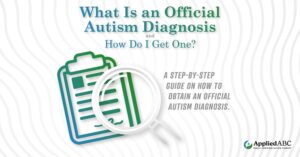An official autism diagnosis requires several conditions and clinical assessments. As you seek professional help to get an official autism diagnosis for your child, find out what to expect from an official diagnosis, where to start, and how long the process may take.
The steps to get an official diagnosis include:
-
Understanding developmental milestones
-
Seeking professional help
-
Undergo a clinical interview and testing
Where to Start: Understanding Developmental Milestones
It’s been nine months since your baby was born, and no matter how many times you say your child’s name, they can’t recognize it.
Your friend’s child, born the same month as yours, clearly shows a range of emotions on their face when they are happy, sad, or surprised.
With your child, what they’re feeling isn’t clear.
When you enter or leave a room, they don’t notice. As other children continue to grow and develop, your child seems to be falling behind. You’re starting to get concerned. But what can you do?
Step 1: Look Through Developmental Milestones
The CDC compiled a comprehensive collection of developmental milestones that offers important clues about your child’s development from two months to five years of age.
These milestones are things most children (75% or more) can do by a certain age.
Not meeting certain developmental milestones can be scary, but there is a lot of help and resources out there to support your child and family.
Suppose your child is not meeting one or more milestones, losing skills they’ve already learned, or showing other concerning behaviors, then it may be time to speak with your child’s doctor and ask about developmental screening. The sooner a child with autism receives a diagnosis, the more effective the treatment can be.
How to Get an Official Autism Diagnosis?
While a list of developmental milestones might be helpful to start, only a specific group of healthcare professional can make the official diagnosis.
Step 2: See a Healthcare Provider
Every child’s journey with autism is unique. If there are concerns about your child’s development, then your child’s doctor may use a screening tool to see if they are on the right developmental track or if they should get more insight from a specialist. This is not an official autism diagnosis!
An official autism diagnosis can only be provided by a specific group of healthcare providers, including:
-
Child psychiatrist/psychologist
-
Pediatric neurologist
-
Developmental pediatrician
-
PsyD (dependent on state)
-
Psychologist (dependent on state)
-
Student under supervision (dependent on state)
-
Behavioral pediatrician
The results pulled from a formal diagnosis can ensure that your child gets the early intervention services they need to help them learn, grow, and lead a more independent life.
What Is Tested During the Diagnosis Process?
Typically, clinicians ready to give an autism diagnosis will provide a clinical interview. Once that is completed, they use reliable diagnostic tools to help them conclude whether or not your child may have autism.
Step 3: The Healthcare Provider Will Conduct a Clinical Interview and Provide Testing
Some of these include:
-
An in-depth developmental history – A detailed timeline of when symptoms started popping up and what external things may have influenced them.
-
Administering research-based testing methods – Some of these include The Social Communication Questionnaire, Autism Spectrum Quotient, Adaptive Behavior Questionnaire, ADOS, and more.
-
Assessments for other mental health conditions – Used to find out if the patient has other conditions alongside autism spectrum disorder.
Why Is Getting an Official Autism Diagnosis Important?
Getting an official autism diagnosis is important so that your child can receive insurance-based ABA therapy services.
One of the most effective forms of treatment for children with autism spectrum disorder is called Applied Behavior Analysis (ABA) therapy. ABA therapy focuses on improving specific behaviors like communication, social skills, independence, personal hygiene, and more.
Click here to learn more about ABA therapy.
Insurance companies will almost always require that your child has an official autism diagnosis to receive ABA services. This is because most state mandates only require insurance companies to cover ABA for children who have an autism diagnosis.
Why Is Getting an Autism Diagnosis so Difficult?
Getting an autism diagnosis can be difficult because of the in-depth assessment process and because of changes to what an autism diagnosis means.
The sooner your child can receive therapy, the more of an impact the treatment will have. Research points out that the average age for a diagnosis is three years old – but it is possible to receive an autism diagnosis as early as 18 months old.
Often, parents may try to receive an autism diagnosis right when symptoms start to manifest. Often, they are kept waiting.
One article showed that “Although the recommended maximum wait time between initial referral and ASD diagnosis is five months, the average time between parents’ initial concerns with their child’s development and diagnosis is generally between 2 and 4 years.”
While Judith Miller, the Clinical Training Director at the Center for Autism Research at the Children’s Hospital of Philadelphia, says that it can take anywhere from 2 to 18 months to receive a diagnosis.
How Long Is an Assessment?
One of the reasons why the diagnosis process takes a long time is the in-depth assessment process itself. The standard assessment tool, called the ADOS—the Autism Diagnostic Observation Schedule—takes 30 minutes. And it’s meant to be paired with a structured interview with parents about current and past symptoms.
This process can take several hours to do.
Also, because the guidelines for what is considered an autism diagnosis have become more inclusive over time, the demand for diagnoses has increased because so many more signs could qualify for an autism diagnosis.
Today, 1 in 36 children has been diagnosed with autism in the United States.
As screening methods become more efficient, this number may change; it could even grow. All that means is that more children with autism will gain access to life-changing treatment.
Official Autism Diagnoses at Applied ABC
Applied ABC requires your child to receive an official autism diagnosis before receiving our sevices.
While we cannot offer to do an in-house diagnosis, we can refer you to a care provider who can provide a proper diagnosis.
If you’ve received an official diagnosis, we have many options to support you and your child.
Our ABA services include:
-
Home-based autism therapy
-
In-center treatment options*
-
In-school autism therapy services
-
Social Skills Groups
-
Free parent training
Getting Started with Applied ABC
If you’re ready to find out if Applied ABC is a good fit for your family, fill out our Getting Started application.
Sources Cited
Centers for Disease Control and Prevention. CDC’s Developmental Milestones.
Mandell, David, Novak, Maytali, Zubritsky, Cynthia. Factors Associated With Age of Diagnosis Among Children With Autism Spectrum Disorders.
Nouvelle, Chloe. As Autism Rates Increase, So Do Wait Times to See a Specialist.
Smith-Young, Joanne, Chafe, Roger, Audas, Rick. “Managing the Wait:” Parents’ Experiences in Accessing Diagnostic and Treatment Services for Children and Adolescents Diagnosed With Autism Spectrum Disorder.







